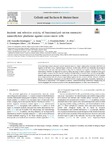Mostrar o rexistro simple do ítem
Intrinsic and Selective Activity of Functionalized Carbon Nanotube/Nanocellulose Platforms Against Colon Cancer Cells
| dc.contributor.author | González-Domínguez, José Miguel | |
| dc.contributor.author | Grasa, Laura | |
| dc.contributor.author | Frontiñán, Javier | |
| dc.contributor.author | Abás, Elisa | |
| dc.contributor.author | Domínguez-Alfaro, Antonio | |
| dc.contributor.author | Mesonero, J. E. | |
| dc.contributor.author | Criado, Alejandro | |
| dc.contributor.author | Ansón-Casaos, Alejandro | |
| dc.date.accessioned | 2022-09-08T08:58:45Z | |
| dc.date.available | 2022-09-08T08:58:45Z | |
| dc.date.issued | 2022-01-25 | |
| dc.identifier.citation | J.M. González-Domínguez, L. Grasa, J. Frontiñán-Rubio, E. Abás, A. Domínguez-Alfaro, J.E. Mesonero, A. Criado, A. Ansón-Casaos, Intrinsic and selective activity of functionalized carbon nanotube/nanocellulose platforms against colon cancer cells, Colloids and Surfaces B: Biointerfaces. 212 (2022). https://doi.org/10.1016/j.colsurfb.2022.112363 | es_ES |
| dc.identifier.issn | 0927-7765 | |
| dc.identifier.uri | http://hdl.handle.net/2183/31531 | |
| dc.description.abstract | [Abstract] Given their large surface area and versatile chemical reactivity, single-walled carbon nanotubes (SWCNTs) are regarded as the basis of new pharmacological complexes. In this study, SWCNTs are chemically functionalized with fluorescein, folic acid, and capecitabine, a drug that is commonly used against colorectal cancer. These functionalized SWCNTs are dispersed in water by taking advantage of their synergistic interaction with type-II nanocrystalline cellulose (II-NCC), and the resulting colloidal system is tested in vitro on both normal (differentiated) and cancerous (proliferative) human colon cells (Caco-2). The functionalized SWCNT/II-NCC hybrids show a higher activity than the reference (capecitabine) against the Caco-2 cancer cell line. However, this effect appears to be intrinsically associated with the SWCNT/II-NCC complex, particularly boosted by fluorescein, as the presence of capecitabine is not required. In addition, confocal microscopy fluorescence imaging using cell cultures highlights the enormous potential of this nanohybrid platform for colon cancer theranostics. | es_ES |
| dc.description.sponsorship | This research was funded by the regional government of Aragón, DGA (Grupos Reconocidos DGA-T03_17R, DGA-T03_20R and DGA-A20_20R), together with associated EU Regional Development Funds, and also the Spanish MINEICO through a “Juan de la Cierva Incorporación” contract, and their associated research funds (ref. IJCI-2016–27789). A.C. thanks the Xunta de Galicia for an “Atracción de Talento” research grant (no. ED431H 2020/17) | es_ES |
| dc.description.sponsorship | Gobierno de Aragón; DGA-T03_17R | es_ES |
| dc.description.sponsorship | Gobierno de Aragón; DGA-T03_20R | es_ES |
| dc.description.sponsorship | Gobierno de Aragón; DGA-A20_20R | es_ES |
| dc.description.sponsorship | Xunta de Galicia; ED431H 2020/17 | es_ES |
| dc.language.iso | eng | es_ES |
| dc.publisher | Elsevier | es_ES |
| dc.relation | info:eu-repo/grantAgreement/AEI/Plan Estatal de Investigación Científica y Técnica y de Innovación 2013-2016/IJCI-2016–27789/ES/ | |
| dc.relation.uri | https://doi.org/10.1016/j.colsurfb.2022.112363 | es_ES |
| dc.rights | Atribución-NoComercial-SinDerivadas 4.0 Internacional | es_ES |
| dc.rights.uri | http://creativecommons.org/licenses/by-nc-nd/4.0/ | * |
| dc.subject | Carbon nanotubes | es_ES |
| dc.subject | Nanocellulose | es_ES |
| dc.subject | Fluorescein | es_ES |
| dc.subject | Caco-2 cells | es_ES |
| dc.subject | Chemotherapy | es_ES |
| dc.subject | Theranostics | es_ES |
| dc.title | Intrinsic and Selective Activity of Functionalized Carbon Nanotube/Nanocellulose Platforms Against Colon Cancer Cells | es_ES |
| dc.type | info:eu-repo/semantics/article | es_ES |
| dc.rights.access | info:eu-repo/semantics/openAccess | es_ES |
| UDC.journalTitle | Colloids and Surfaces B: Biointerfaces | es_ES |
| UDC.volume | 212 | es_ES |
| UDC.startPage | 112363 | es_ES |
| dc.identifier.doi | 10.1016/j.colsurfb.2022.112363 |






